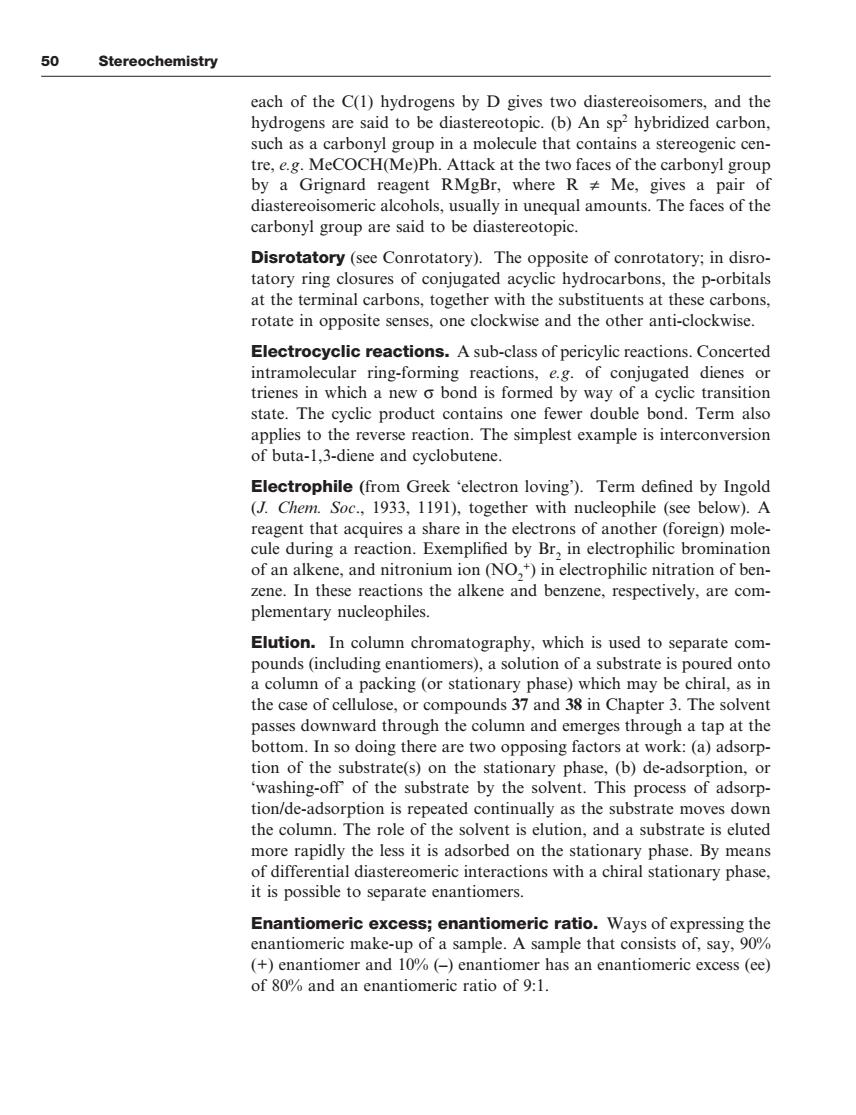正在加载图片...

50 Stereochemistry each of the C(1)hydrogens by D gives two diastereoisomers.and the eogenic cen tre,e.g.MeCOCH(Me)Ph.Attack at the two faces of the carbonyl group by a Grignard reagent RMgBr,where R Me,gives a pair of diastereoisomeric alcohols,usually in unequal amounts.The faces of the carbonyl group are said to be diastereotopic. Disrotatory(see Conrotatory).The opposite of conrotatory:in disro tatory ring closures of conjugated acyclic hydrocarbons,the p-orbitals at the terminal carbons,together with the substituents at these carbons, rotate in opposite senses,one clockwise and the other anti-clockwise. Electrocyclic reactions.A sub-class of pericylic reactions.Concerted intramolecula ring-forming reactions,e.g.of conjugated dienes or trienes in which a new o bond is formed by way of a cyclic transition state.The cyclic product contains one fewer double bond.Term also to the reverse racton.The simplest examplstr buta-1,3-diene and cyclobutene Electrophile(from Greek 'electron loving).Term defined by Ingold (J.Chem.Soc.,1933,1191),together with nucleophile (see below).A reagent that acquires a share in the electrons of another(foreign)mole- cule during a reaction.Exemplified by Br,in electrophilic bromination of an alk ne,and nitronium on(NO,)in electrophilic nitration of ben zene.In these reactions the alkene and benzene,respectively,are com- plementary nucleophiles. Elution.In column chromatography,which is used to separate com- pounds()a substrate is oured onto a column acking (statio y phase)which may be the case of cellulose,or compounds 37 and 38 in Chapter 3.The solvent passes downward through the column and emerges through a tap at the bottom.In so doing there are two opposing factors at work:(a)adsorp- tion of the substrate(s)on the stationary phase,(b)de-adsorption, washing-of of the substrate by the sove ent.This pro cess of tion/de-adsorption is repeated continually as the substrate moves down the column.The role of the solvent is elution.and a substrate is eluted more rapidly the less it is adsorbed on the stationary phase.By means of differential diastereomeric interactions with a chiral stationary phase. it is possible to separate enantio Enantiomeric excess;enantiomeric ratio.Ways of expressing the enantiomeric make-up of a sample.A sample that consists of,say,90% (+)enantiomer and 10%(-)enantiomer has an enantiomeric excess (ee) of 80%and an enantiomeric ratio of 9:1.each of the C(1) hydrogens by D gives two diastereoisomers, and the hydrogens are said to be diastereotopic. (b) An sp2 hybridized carbon, such as a carbonyl group in a molecule that contains a stereogenic centre, e.g. MeCOCH(Me)Ph. Attack at the two faces of the carbonyl group by a Grignard reagent RMgBr, where R ≠ Me, gives a pair of diastereoisomeric alcohols, usually in unequal amounts. The faces of the carbonyl group are said to be diastereotopic. Disrotatory (see Conrotatory). The opposite of conrotatory; in disrotatory ring closures of conjugated acyclic hydrocarbons, the p-orbitals at the terminal carbons, together with the substituents at these carbons, rotate in opposite senses, one clockwise and the other anti-clockwise. Electrocyclic reactions. A sub-class of pericylic reactions. Concerted intramolecular ring-forming reactions, e.g. of conjugated dienes or trienes in which a new σ bond is formed by way of a cyclic transition state. The cyclic product contains one fewer double bond. Term also applies to the reverse reaction. The simplest example is interconversion of buta-1,3-diene and cyclobutene. Electrophile (from Greek ‘electron loving’). Term defined by Ingold (J. Chem. Soc., 1933, 1191), together with nucleophile (see below). A reagent that acquires a share in the electrons of another (foreign) molecule during a reaction. Exemplified by Br2 in electrophilic bromination of an alkene, and nitronium ion (NO2 +) in electrophilic nitration of benzene. In these reactions the alkene and benzene, respectively, are complementary nucleophiles. Elution. In column chromatography, which is used to separate compounds (including enantiomers), a solution of a substrate is poured onto a column of a packing (or stationary phase) which may be chiral, as in the case of cellulose, or compounds 37 and 38 in Chapter 3. The solvent passes downward through the column and emerges through a tap at the bottom. In so doing there are two opposing factors at work: (a) adsorption of the substrate(s) on the stationary phase, (b) de-adsorption, or ‘washing-off’ of the substrate by the solvent. This process of adsorption/de-adsorption is repeated continually as the substrate moves down the column. The role of the solvent is elution, and a substrate is eluted more rapidly the less it is adsorbed on the stationary phase. By means of differential diastereomeric interactions with a chiral stationary phase, it is possible to separate enantiomers. Enantiomeric excess; enantiomeric ratio. Ways of expressing the enantiomeric make-up of a sample. A sample that consists of, say, 90% (+) enantiomer and 10% (–) enantiomer has an enantiomeric excess (ee) of 80% and an enantiomeric ratio of 9:1. 50 Stereochemistry